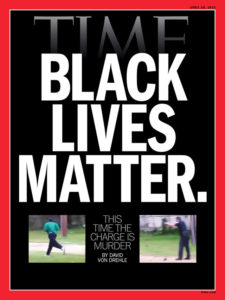There is power in a good story and 2016 was a great example of that. The interesting thing I learned about storytelling in 2016 is that they don’t necessarily have to be 100% true to be effective. Instead, the audience just needs to find their own truth within your narrative.
Let’s take a brief (I promise) look at the 2016 elections. While all the candidates fought tooth and nail to argue their positions, defend their honor and promise to be an anchor for change, the winning candidate is the one who told the most effective story and made a strong emotional connection with his desired target audience. How? Because they saw their own truth reflected in the narrative that the candidate was presenting. Whether or not he was the right fit for the job is beside the point. He used the art of storytelling to become the leader of the free world.

Another example of how storytelling can be a powerful tool to ignite action is the success of the Black Lives Matter movement. Considered one of the most successful grassroots movements in recent history, BLM didn’t gain popularity through splashy advertising or skillful art direction. Instead, the growth of the BLM movement can be largely attributed to the fact that millions of Americans could connect their own stories of suffering and injustice to the narrative told by BLM. Essentially, BLM made millions of people feel that their own stories mattered.
What does this mean if you’re a brand looking to market yourself effectively to a target audience? While clever calls-to-action and innovative campaigns are good and well, these tactics will fall flat and get lost in the crowded cyberspace of content if your company isn’t telling a strategic story about your brand. Textbook marketers have been preaching the importance of features, benefits, and CTAs for years, and they aren’t wrong. However, these elements should simply be a part of the high-level brand story you’re spreading about your product or service. Effectively weaving these elements into your story, similar to how an author will offer background information about a novel before the plot thickens, is important but shouldn’t be the primary focus.
Before you can successfully use storytelling to market your brand, you must first learn the typical structure and how to utilize this structure when crafting your brand story.
The Structure of a Story
While there are many different methods of structuring a story, the most popular and commonly used structure follows this order: Exposition > Rising Action > Climax > Resolution
- Exposition
The exposition is the background information about the character(s) and setting in a story. In most novels, this is when the author will explain where the main characters are from, what kind of lives they live and what their current surroundings are. In your brand story, this is when you would introduce your characters and what their lives look like to your audience. To clarify, the characters of your brand story should be modeled after your customers–why else would they care to know it? When crafting a backstory for your target audience, we recommend creating target personas for your customers by using research and data-driven insights. You can choose to use just one main character or several main characters–they should be your primary and secondary target customers.
Some brands make the mistake of being too vague and open-ended in an effort to reach a wider audience. However, according to the founder of Narrative Leadership Associates, Geoff Mead, “stories involve specific events that happen to particular characters, so narratives that veer towards generalities, explanations and abstractions have abandoned storytelling in favor of advocacy”. I couldn’t agree more. Your target personas should be detailed, specific and authentic because while your customer base will share some high-level similarities, the more you tailor your story to their unique needs and motivations, the more they will connect with your brand.

A brand that has executed this well is the wildly popular, philanthropic shoe company, TOMS. TOMS has effectively connected with millions of do-gooders around the world by telling a meaningful and strategic story about their founder, Blake Mycoskie. Blake was a free-spirited traveler who was touched by the immense need in countries he backpacked through such as Argentina and Peru. Their brand story describes how, after trying to fund donations himself, Blake decided to create a shoe brand that helped pay the cost of new shoes for those in need. This simple story of how one regular Joe created a multi-million dollar company in an effort to make a difference in the lives of people he encountered during his travels resonated with many people around the world. Their audience felt the same urge to do their part to change the world and became loyal customers in the process. Thanks to their brand story and smart business model, TOMS now provides shoes, water, and medical care all around the world. By connecting the story of their founder to their target customer, TOMS raked in almost $400 million in revenue last year. The exposition portion of TOMS brand story has been invaluable in gaining a huge following of faithful customers that see themselves in the TOMS brand story–and TOMS is reaping the benefits all the way to the bank.
Setting the stage for your brand story is also an important section of the exposition. Key data points such as career, income level, hobbies and geographical information gathered through research will provide directional cues when setting the stage for your brand story. Your exposition can also be where you introduce the features and benefits of your product or service. While you aren’t explaining how the features or benefits of your product solve your character’s conflict just yet, providing insight into what makes your product or service unique can help position your brand in a favorable light as the audience transitions into the next portion of your brand story.
2. Rising Action
P&G ‘Thank you, Mom’ Commercial
Rising action introduces and develops the tension in your story. Rising action involves a certain internal conflict that the main character is experiencing. As much as we’d like to deny it, human beings love drama which is why your brand story needs a level of angst to keep your audience hooked. Rising action is what builds anticipation and suspense, keeping the audience anxiously turning the page to learn what the main character(s) will do next.
In your brand story, this conflict should be the customer problem that your brand will solve. This customer conflict should be one that your target audience feels is consistent with who the character (or themselves) are. The best way to uncover your customer problems are by conducting target customer research but don’t try to solve them all. Pick the problem you feel causes the most tension in your customer’s life and focus on that.
For example, in P&G’s nationally-acclaimed campaign for the 2016 Rio Olympics named ‘Thank you, Mom‘, the characters highlighted are the P&G moms all over the world. The rising action of the spot showed Olympic athletes who are seconds away from entering into their competition. As the pressure of the biggest moment of their lives builds, they recall how their mothers soothed their fears when they encountered a conflict or challenge in the past. The spot also made sure to highlight what helped these moms be better at their superhuman roles–P&G products. Even though this advertisement didn’t necessarily focus on a customer pain point related to their product, it focused on a pain point that their target customer (moms) experience in their everyday lives, which is to be the primary source of encouragement for their children. When choosing a conflict to highlight in your story, you can either focus on a direct conflict or indirect conflict.
Direct conflict – This is an objective problem that is directly solved by your product or service.
Example: Your customer is experiencing frustration with long lines at restaurants when ordering pick-up. Your mobile app allows customers to skip the line and pick up their food as soon as they arrive.
Indirect conflict – A subjective or moral conflict that is indirectly solved by your product or service.
Example: Your customer is experiencing a need to wear environmentally-conscious clothing without the high price. Your company makes locally-sourced, handmade eco-friendly clothing that costs the same as mass produced apparel.
There’s no one rule when it comes to identifying a customer conflict. Simply look to address a problem, need or internal motivation of your customer that can directly or indirectly be solved by your product.
3. Climax
All State’s ‘Mayhem’ Commerical
The climax is the highest point of tension in your story. It is where the conflict you’ve presented in the rising action will reach its boiling point. For marketers, this is when your brand can truly shine. In a story, a good climax contains several key elements. These key elements can be mimicked in your brand story, you just need to know who’s who.
- Hero – Your brand
- Main Character – Your customer
- Villain – Your customer’s problem or internal conflict
The best example of a brand campaign that perfectly depicts the interaction between the hero, main character and villain is Allstate’s ‘Mayhem‘ campaign. This campaign was highly creative, comedic and a home run with audiences and industry alike–not only because it was enjoyable to watch but because the roles were clearly defined and creatively communicated. This campaign was not only buzzworthy, it was strategic storytelling. Any person that needs insurance can relate to feeling helpless and unprepared when life’s mayhem comes knocking on their door. The solution? Call Allstate, and a 4.3% increase in sales showed that thousands of people did just that.
4. Resolution
The resolution of a story, also known as the denouement, is the conclusion of the story’s plot. This is when any unanswered questions are resolved and loose ends are tied. Also, this is when the audience learns what happens to the characters after their conflict has been resolved.
In a brand story, this section can be rather simple. The question to be answered here is what is your customer’s new normal after your product or service resolved their conflict and eliminated their tension? While some campaigns fail to address this section, the promise of a better life because of your product is the ultimate reason why your target customer should want to use your product–so don’t miss the opportunity to show them how your brand will improve their lives.
To further drive this point home, is the reason a mom wants a faster-acting dish soap because she gets a thrill from seeing her dishes get clean faster? While that may also be the case, it’s more likely that what she truly desires are those extra few minutes with her kids before bedtime. This is the new normal that better dish soap offers her. As basic as that example is, a brand that can correctly identify why customers seek a certain feature or benefit of their product can utilize this information when crafting a memorable resolution for their brand story. Identifying your customer’s high-level motivation boils down to thorough target customer research. If you’ve noticed a common thread here, it’s on purpose–customer research is key to developing a strategic and effective brand story. In this case, customer reviews can be a gold mine of information to use in your resolution.
Types of Stories to Market Your Brand
Now that you’ve learned how to structure your brand story, it’s important to learn the different types of plot lines you can use to market your brand. According to Christopher Booker’s 2004 publication, The Seven Basic Plots: Why We Tell Stories, there are 7 basic story plot lines to consider. While all these will follow the general order of exposition, rising action, climax, and resolution, they have different high-level themes that can be applied to your own brand mantra.
- The Quest – When the main character takes a journey with several obstacles to overcome in the hopes of reaching their final destination. I.e., a brand story about how a customer used your product or service to accomplish an unlikely yet victorious feat.
Example: IBM’s Smarter Planet commercial
- Overcoming the Villain – Similar to the quest, the main character of the story is met with his ultimate nemesis who is larger than life and near impossible to defeat. However, through strength and courage, the protagonist perseveres. I.e., a brand story about how your product or service helped the underdog defeat a stronger opponent.
Example: Nike’s Just Do It commercial
- Rags to Riches – The main character fought to make something out of nothing. It is not so much about the materialistic aspect as it is about the will of the main character to succeed. I.e., similar to how the founder of TOMS turned a simple act of volunteerism into a multi-million dollar company, describe your brand’s journey from nothing to something.
Example: TOMS founder Blake Mycoskie’s interview with Inc. magazine
- The Rebirth – The main character’s transformation from adolescence to growth and maturity accompanied by the struggle that leads to the final stage of rebirth or new life. I.e., a brand story about how your product or service has been by your customer’s side at various stages of their life.
Example: Prudential’s Day One commercial
- Voyage and Return – This is similar to rebirth except that the main character went on a journey that changed them and even though they returned to where they began, they will never be the same as before. I.e., a brand story about how your product or service is a catalyst to your customer’s self-exploration or finding their true self.
Example: Corona’s Find Your Beach commercial
- Tragedy – This is similar to the quest, only that the main character is faced with an event of much sadness and despair. The aftermath of tragedy is the lesson or enlightenment–due to the serious tone of this plot, most brands will stay away from this type of story except for PSAs and charity organizations.
Example: World No Tobacco Day commercial
- Comedy – This is the most popular yet most difficult to execute. Brands that get this right enjoy immense success like Old Spice’s The man your man could smell like or Snicker’s Hangry.
Example: Old Spice’s The Man Your Man Could Smell Like commercial
As your customer continues to grow savvier and more resistant to slapstick marketing and advertising, storytelling can be a valuable tool in your brand marketing arsenal. Stories are what make the world go round–this is why real-life stories that get picked up by online media outlets get more views than most marketing and advertising campaigns. There is something authentic and substantial about a story about real people that taps into the human’s psyche better than even the catchiest tagline can. While a clever line may catch your customer’s attention for a moment, a story that resonates with them will make a much deeper impact and holds the power to turn a reluctant audience into a committed customer. In the beginning of this post, I mentioned that the best stories don’t have to be 100% true to be effective. While I am not suggesting that you sacrifice truth and authenticity to create your brand story, you only need to tell the part that connects your brand to your customer’s story. This connection is the magic that will give you more likes, conversions, and sales than shoving CTAs down your customer’s throat.
Does your brand have a story to tell but you don’t know where to start? Let the strategic storytellers at iPullRank help–we’ll give your brand the visibility it deserves.
Dinuki Suraweera is a copywriter at iPullRank. She has been featured on the HuffPost, The Thought Catalog & Elite Daily.







